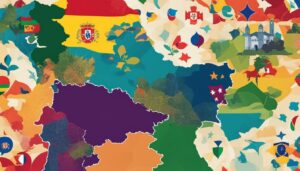Sweden is known for its rich linguistic landscape, with the Swedish language being the official and most commonly spoken language in the country. Swedish is a North Germanic language that shares similarities with Danish and Norwegian. It has several regional dialects that add diversity to the language.
In addition to Swedish, there are a wide range of other languages spoken in Sweden. The indigenous Sámi languages, along with immigrant languages like Arabic, Serbo-Croatian, Greek, and Spanish, contribute to the linguistic diversity of the country.
English is widely spoken in Sweden, with an impressive 90% of the population having some proficiency in the language. This high level of English proficiency adds to the country’s global connectivity and makes it easier for visitors and expatriates to communicate.
Finnish, along with Meänkieli, Romani, Yiddish, and Swedish Sign Language, are recognized as official minority languages in Sweden. This recognition highlights the country’s commitment to promoting linguistic inclusivity and preserving the cultural heritage of various minority communities.
It is worth noting that Swedish also has influence beyond Sweden’s borders. In Finland, Swedish is recognized as the second official language, further demonstrating the importance and reach of the Swedish language.
Key Takeaways:
- Swedish is the official and most commonly spoken language in Sweden.
- Sweden has a diverse linguistic landscape with regional dialects.
- Other languages spoken in Sweden include the indigenous Sámi languages and immigrant languages like Arabic, Serbo-Croatian, Greek, and Spanish.
- English is widely spoken, with 90% of the population having some proficiency in the language.
- Finnish, Meänkieli, Romani, Yiddish, and Swedish Sign Language are recognized as official minority languages in Sweden.
The Swedish Language and its Dialects
The Swedish language, a North Germanic language, is the primary language spoken in Sweden, with various dialects adding nuances to the linguistic landscape. Swedish is closely related to both Danish and Norwegian, forming a linguistic continuum known as the Scandinavian languages. Within Sweden itself, different regions have their own distinct dialects, each with its own unique features.
One notable dialect is the Scanian dialect, spoken in the southernmost part of Sweden. It has its roots in Old Norse, the ancient language spoken by the Vikings. The Scanian dialect is characterized by its melodic intonation and distinct vocabulary, which sets it apart from the standard Swedish used in the rest of the country.
Another dialect worth mentioning is the Norrlandic dialect, spoken in the northern parts of Sweden. This dialect is known for its elongated vowels and the use of retroflex consonants, giving it a distinct sound. The Norrlandic dialect also has some influences from the Sami languages, which are spoken by the indigenous Sami people in the northern regions of Sweden.
| Dialect | Description |
|---|---|
| Scanian | A dialect spoken in southern Sweden with roots in Old Norse, characterized by a melodic intonation and unique vocabulary. |
| Norrlandic | A dialect spoken in the northern parts of Sweden, known for elongated vowels and retroflex consonants, influenced by Sami languages. |
| Gotlandic | Spoken on the island of Gotland, this dialect has distinct features such as a shift in the pronunciation of certain vowels. |
In addition to these regional dialects, there are also sociolects that develop based on social factors such as age, education, and socioeconomic status. These sociolects can influence word choice, pronunciation, and grammar, further adding to the linguistic diversity in Sweden.
Overall, the Swedish language and its various dialects play an integral role in shaping the cultural and linguistic identity of Sweden. They reflect the country’s rich history and diversity, making it a fascinating subject of study for linguists and language enthusiasts alike.
Other Languages Spoken in Sweden
In addition to Swedish, Sweden is home to a range of languages, including the indigenous Sámi languages, immigrant languages, and widely spoken English. The indigenous Sámi languages, including North, South, Lule, Inari, and Skolt Sámi, are spoken by the Sámi people, who are indigenous to the Arctic region of Sweden.
“Language is an essential part of our Sámi culture,” says Nils Johansson, a Sámi language teacher.
It connects us to our ancestors and helps us preserve our unique identity.
In addition to the Sámi languages, Sweden is also home to a diverse range of immigrant languages. Due to immigration from various countries, languages such as Arabic, Serbo-Croatian, Greek, and Spanish have become prevalent in different parts of the country. This multicultural linguistic landscape contributes to the rich tapestry of Sweden’s society.
English and Finnish
English is widely spoken and understood in Sweden, with about 90% of the population having some proficiency in the language. It is taught in schools from an early age and is commonly used in business, education, and tourism. This high level of English proficiency makes Sweden an ideal destination for international visitors and expatriates.
Finnish, the language spoken in neighboring Finland, is recognized as an official minority language in Sweden. Along with Finnish, other minority languages in Sweden include Meänkieli, Romani, Yiddish, and Swedish Sign Language. These languages play an important role in the cultural heritage of their respective communities.
| Language | Official Status | Number of Speakers |
|---|---|---|
| Finnish | Official Minority Language | Approximately 50,000 |
| Meänkieli | Official Minority Language | Approximately 10,000 |
| Romani | Official Minority Language | Approximately 9,000 |
| Yiddish | Official Minority Language | Approximately 8,000 |
| Swedish Sign Language | Official Minority Language | Approximately 10,000 |
Furthermore, it is worth mentioning that Swedish is the second official language of Finland. Learning Swedish can provide access to both Danish and Norwegian, as these languages share similarities with Swedish. This opens up opportunities for communication and cultural exchange within the Nordic countries.
Importance of English in Sweden
The English language holds great importance in Sweden, with approximately 90% of the population having some level of proficiency in the language. This high level of proficiency is attributed to the country’s emphasis on education and its commitment to providing quality English language instruction from an early age. English is often taught as a mandatory subject in Swedish schools, starting as early as the first grade.
English proficiency in Sweden is also reinforced by the widespread exposure to English-language media and entertainment. Swedish television programs and films often feature English subtitles rather than dubbing, allowing viewers to develop their English language skills. Similarly, popular music and literature in Sweden are often in English, further promoting familiarity and fluency in the language.
As a result of this strong focus on English language education and exposure, Sweden has become known for its high English proficiency levels, ranking consistently among the top countries in English language proficiency indexes. This proficiency in English not only facilitates communication with international visitors and business partners but also provides opportunities for Swedes to study and work abroad, expanding their horizons and global perspectives.
The Benefits of Bilingualism
Being bilingual in Swedish and English also opens doors for Swedes to access a wealth of educational and professional opportunities beyond the borders of their own country. With English being one of the most widely spoken languages globally, proficiency in the language allows Swedes to engage with a diverse range of cultures, communities, and industries worldwide.
Moreover, learning English provides a gateway to mastering other Scandinavian languages such as Danish and Norwegian. The similarities between these languages make it easier for Swedes to understand and communicate with their neighboring countries, fostering cultural exchange and collaboration.
In conclusion, the English language’s importance in Sweden cannot be overstated. It serves as a vital tool for communication, opens up international opportunities, and fosters cultural exchange. With the majority of the population having some level of proficiency in English, Sweden continues to demonstrate its commitment to multilingualism and global engagement.
Multilingualism in Sweden
The multilingual nature of Sweden offers opportunities for language enthusiasts, as learning Swedish can open doors to understanding other Scandinavian languages like Danish and Norwegian. As the official language of Sweden, Swedish is spoken by the majority of the population and serves as the primary means of communication in various aspects of daily life.
In addition to Swedish, there are several other languages spoken in Sweden due to its diverse population. Immigrant languages such as Arabic, Serbo-Croatian, Greek, and Spanish have gained prominence, reflecting the country’s multicultural and inclusive society. The indigenous Sámi languages, spoken by the Sámi people, are also recognized and actively preserved.
English, as a lingua franca, is widely spoken in Sweden, with approximately 90% of the population having some level of proficiency in the language. This high level of English proficiency not only facilitates communication with international visitors but also enhances opportunities for education, travel, and business.
Learning Swedish and Access to Danish and Norwegian
For language enthusiasts seeking to explore the Scandinavian region, learning Swedish can be a gateway to understanding other Nordic languages. Danish and Norwegian, which are closely related to Swedish, share similarities in vocabulary and grammar, making the learning process more accessible and efficient.
By gaining proficiency in Swedish, language learners can easily transition to understanding Danish and Norwegian, opening up a wider range of cultural experiences and communication opportunities. Whether it’s diving into Danish literature, enjoying Norwegian films, or engaging with the vibrant Nordic community, the ability to navigate multiple Scandinavian languages enhances cross-cultural interactions and deepens appreciation for the region’s rich linguistic heritage.
| Language | Status |
|---|---|
| Finnish | Official minority language |
| Meänkieli | Official minority language |
| Romani | Official minority language |
| Yiddish | Official minority language |
| Swedish Sign Language | Official minority language |
It’s important to note that Swedish itself is an official minority language in Finland, further demonstrating the influence and interconnectedness of the Swedish language beyond Sweden’s borders.
Recognition of Minority Languages
Sweden recognizes the importance of preserving minority languages, with Finnish, Meänkieli, Romani, Yiddish, and Swedish Sign Language being officially recognized as minority languages in the country. This recognition highlights Sweden’s commitment to linguistic diversity and inclusivity.
Finnish: Finnish is spoken by a significant number of people in Sweden, particularly in the northern regions. It is recognized as an official minority language due to the historical and cultural ties between Sweden and Finland.
Meänkieli: Meänkieli, also known as Tornedalen Finnish, is a language spoken by the Finnish-speaking minority in the Tornedalen region, which stretches across the border of Sweden and Finland. It holds official status in Sweden, providing recognition and support for speakers of the language.
Romani, Yiddish, and Swedish Sign Language: In addition to Finnish and Meänkieli, Sweden also recognizes Romani, Yiddish, and Swedish Sign Language as official minority languages. These languages are vital for their respective communities and contribute to the rich cultural tapestry of Sweden.
Table: Official Minority Languages in Sweden
| Language | Recognition Status | Speakers |
|---|---|---|
| Finnish | Official minority language | Approximately 470,000 |
| Meänkieli | Official minority language | Approximately 50,000 |
| Romani | Official minority language | Approximately 9,000 |
| Yiddish | Official minority language | Approximately 150 |
| Swedish Sign Language | Official minority language | Approximately 1,000 |
These official minority languages are not only recognized by the Swedish government but also have organizations and institutions dedicated to their preservation and promotion. They play an essential role in maintaining cultural heritage and fostering a sense of belonging for their respective communities.
By acknowledging and supporting these minority languages, Sweden showcases its commitment to linguistic diversity and cultural inclusivity. The recognition of Finnish, Meänkieli, Romani, Yiddish, and Swedish Sign Language as official minority languages is a testament to Sweden’s dedication to preserving and celebrating the country’s multicultural identity.
Swedish Language’s Influence Beyond Sweden
The influence of the Swedish language extends beyond Sweden, as it holds the status of the second official language in Finland. This recognition is a testament to the historical and cultural ties between the two countries. It also highlights the importance of the Swedish language in Finland’s linguistic landscape.
Finland, a neighboring country to Sweden, has a significant Swedish-speaking minority population, particularly along the coastal regions. Swedish is widely used in official communications, education, and administration, alongside Finnish. Both languages have equal standing, and the bilingualism reflects Finland’s commitment to preserving its Swedish-speaking heritage.
The acknowledgment of Swedish as the second official language in Finland provides opportunities for cultural exchange, trade, and cooperation between the two countries. It facilitates smoother communication and strengthens the bonds shared by Swedish and Finnish speakers. It also underscores the significance of multilingualism in the region, fostering an environment of linguistic diversity and understanding.
| Key Points: | Swedish Language’s Influence Beyond Sweden |
|---|---|
| The second official language in Finland | Highlights historical and cultural ties between Sweden and Finland |
| Significant Swedish-speaking minority population | Preserves the Swedish-speaking heritage in Finland |
| Fosters cultural exchange and cooperation | Strengthens bonds between Swedish and Finnish speakers |
| Emphasizes the importance of multilingualism | Supports linguistic diversity and understanding |
Conclusion
In conclusion, Sweden’s linguistic landscape is characterized by the Swedish language as the official and most commonly spoken language, accompanied by a diverse array of other languages reflecting the multicultural society of the country.
The Swedish language, a North Germanic language closely related to Danish and Norwegian, holds significant importance in Sweden. It is spoken by the majority of the population and serves as a unifying force for the nation.
However, Sweden is also home to a rich tapestry of other languages. The indigenous Sámi languages, spoken by the Sámi people, are an integral part of the country’s cultural heritage. Additionally, the presence of immigrant languages such as Arabic, Serbo-Croatian, Greek, and Spanish reflects the diverse backgrounds of the Swedish population.
English has a prominent role in Sweden as well. With approximately 90% of the population having some level of proficiency in the language, English is widely spoken and understood. This proficiency in English opens up opportunities for communication, business, and education on an international level.
Furthermore, Sweden recognizes the importance of minority languages within its borders. Finnish, along with Meänkieli, Romani, Yiddish, and Swedish Sign Language, holds official minority language status in the country. This recognition serves to preserve and celebrate linguistic diversity.
Finally, the Swedish language extends its influence beyond Sweden’s borders. It is the second official language of neighboring Finland, further highlighting its significance in the Scandinavian region. Learning Swedish can also provide access to Danish and Norwegian, facilitating communication across the Nordic countries.
FAQ
What language do they speak in Sweden?
The official language spoken in Sweden is Swedish.
Are there any dialects of the Swedish language?
Yes, there are several regional dialects spoken across the country.
Are there other languages spoken in Sweden?
Yes, in addition to Swedish, there are many other languages spoken in Sweden, including the indigenous Sámi languages and immigrant languages such as Arabic, Serbo-Croatian, Greek, and Spanish.
How widely spoken is English in Sweden?
English is widely spoken in Sweden, with 90% of the population having some proficiency in the language.
Is Finnish recognized as a language in Sweden?
Yes, Finnish is recognized as an official minority language in Sweden, along with Meänkieli, Romani, Yiddish, and Swedish Sign Language.
Does learning Swedish provide access to other Scandinavian languages?
Yes, learning Swedish can provide access to Danish and Norwegian as well.
Is Swedish spoken outside of Sweden?
Yes, Swedish is the second official language of Finland.



